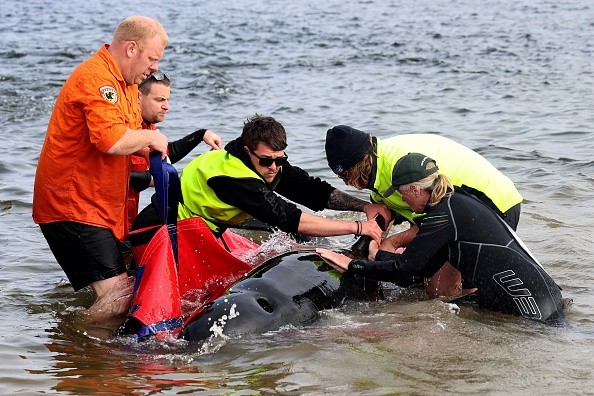Nearly 230 pilot whales were stranded on Tasmania's coast Wednesday, prompting marine conservationists to rescue the whales immediately.
In a report, Sydney Morning Herald said that the mass stranding of pilot whales happened on Ocean Beach near Macquarie Harbour, south of Strahan.
The news report added that half of the pod could be alive.
Immediately, the Department of Natural Resources and Environment Tasmania said that rescuers were on the coast equipped with gears to rescue the stranded pilot whales on the beach.
In an interview with BBC, AccuWeather reported that Wildlife scientist Vanessa Pirotta said that the stranding of pilot whales is unusual and concerning, which happened with the same species and location before.
Based on the reports, 500 whales were also stranded in September 2020 in the same location.
Stranded Whales a Mystery

Moreover, the wildlife scientists explained climate change could impact the stranded whales or follow a disoriented pilot whale leader. However, she stressed that the main reasons for stranding are still a mystery.
According to the Department of Natural Resources and Environment Tasmania, the invaluable help of aquaculture companies and a telehandler helped lift the affected pilot whales.
The same report added that they would focus on removing about 200 deceased whales after the rescue.
Marine wildlife experts will investigate the reason behind the stranded whales. However, the environment of Tasmania said that the cause of stranding is still unknown.
This week, a stranding of over 14 male sperm eventually died on King Island, located to the north of Tasmania.
Also Read: New Research Shows How Marine Predators Find Food Hotspots in Ocean Eddies
According to The Guardian, Prof Karen Stockin, an expert on whale and dolphin strandings at Massey University in New Zealand, explained that the reason for stranding could have multiple causes. She added it could be with the cyclical changes in the ocean temperatures.
Pilot Whales
According to the OCEANA Protecting World Oceans, pilot whales are marine mammals. The name is from the term pilot meaning the pod follows the leader:
- Short-filled pilot whales are Globicephala macrohynchus. It has a white saddle patch that can be seen behind in dorsal fin. They prefer to live in warmer oceans.
- Long-finned pilot whales are G. Melas. They tend to live in temperate and sub-arctic oceans.
- Some pilot whales are black with markings under their bellies.
- Male pilot whales are larger than females. The male can grow to 22 feet in length and weigh up to three tonnes. At six years of age, female pilot whales can reach sexual maturity with the longest birth interval.
- They strongly connect with the matriarchal pod, also treated as a grandmother.
- Pilot whales are efficient hunters in the ocean, capable of holding their breath for 15 minutes and reaching 1,000 meters with a speed of up to 90 kilometers/ hr.
Pilot whales are also considered the second largest species of dolphins. They are known to be social and communal pods.
Moreover, they use their teeth in hunting, also called toothed whales. Despite short-finned and long-finned may look the same, they have different sizes of fins and shapes.
Pilot whales have a lifespan of 45 to 60 years of living.
Related Article: The World's Largest Container Line Reroutes Ships to Avoid Harming Endangered Blue Whales
For more similar, don't forget to follow Nature World News.
© 2024 NatureWorldNews.com All rights reserved. Do not reproduce without permission.




![Roundworms with Short Memories 'Stop Forgetting' When Frozen or Given Lithium [Study]](https://1471793142.rsc.cdn77.org/data/thumbs/full/70295/280/157/50/40/roundworms-with-short-memories-stop-forgetting-when-frozen-or-given-lithium-study.jpg)
